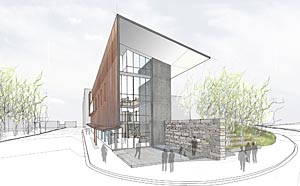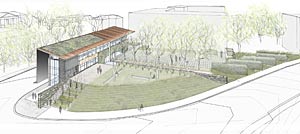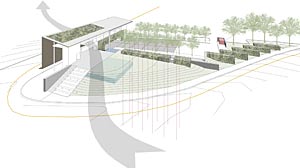Harmon Sews the Seeds of 'Earthy Modernism'
If architecture is didactic, and Frank Harmon, FAIA, thinks it is, then his design for the American Institute of Architects North Carolina (AIA/NC) headquarters in downtown Raleigh is a master course in what the architect calls “earthy Modernism.” The 12,000-square-foot structure is intended to meet both LEED Platinum standards and the American Institute of Architects’ Committee On the Environment objectives. In addition to containing staff offices and a lecture hall for presentations, it will feature less obvious elements such as a community recycling center and an outdoor area for concerts and farmers’ markets. The linear building will consist of four stories of steel, concrete, and glass. A cantilevered roof of either copper or weathering steel will shade a public gathering space, while a berm of stone and earth will surround the structure’s southwest corner.



Images courtesy Frank Harmon, FAIA
The curtain wall and roof of the AIA North Carolina chapter’s new headquarters will project beyond the building envelope to create a sheltered entry porch (top). An earth berm surrounds the building’s southwest corner (middle). In addition to a green roof, to help regulate the building’s indoor climate, its orientation allows for natural ventilation and daylighting (above).
AIA/NC is fortunate to have owned its previous building, giving it enough money to fund the ambitious new $4.5 million project. The headquarters, part of a larger downtown redevelopment plan, sits in an area that David Crawford, the chapter’s executive vice president, refers to as “the entryway into downtown Raleigh and the capitol district.” He adds that the chapter’s leadership wanted its headquarters to be “a teaching tool” about the AIA’s goal of carbon-neutrality by 2030.
In addition to using photovoltaic cells, a rooftop garden, and geothermal wells, Harmon employed traditional techniques that farmers have long used when building their homes, giving the AIA/NC headquarters the soul of a Southern farmhouse. The building will use local materials, when possible, and will include a garden of deciduous trees to shield its windward side. A shaded area beneath the roof’s overhang borrows from the local vernacular: “Basically it’s a porch,” Crawford says.
Harmon’s work often acknowledges buildings designed by non-professional architects, recognizing what he describes as “the genius of the people who live there” as manifested in barns and farmhouses which have stood for decades or centuries. He says his studio practices a kind “critical regionalism that is a form of resistance to 20th century capitalism. It is a return to the basic roots of the place.” And while he was trained in high Modernism, Harmon lists Arts and Crafts progenitor Phillip Webb as one of his great heroes. “The principles we can see embodied in older structures are valuable, often the same as in Modernism,” Harmon says, adding that he considers himself part of the “the next generation. We’re much more aware of the environment.”



Post a comment to this article
Report Abusive Comment